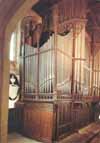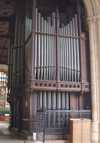For this church:    |
|
 The
current organ, The
current organ,seen from the east |
Early History
The first evidence of an organ in Newark Church is found in the Magnus Foundation deed of 1532, which provided for six boys to be taught “playing at the organs”.
The first direct evidence can be found in the churchwardens’ accounts of 1626, where a payment is recorded “for pullinge the organnes” (ie organ-blowing).
These accounts contain several entries in the ensuing years relating to the organ. For instance in 1636 a payment of six pence was made “To Yoxall [presumably the sexton] for carrying snow forth of the organne chamber stairs”, and one of twelve pence “To Barker for makeing a dore for the same”. The location of the organ chamber at that time is uncertain, but the top of the screen may be indicated since the staircase in the pillar which leads to it does indeed open on the roof.
Repairs were carried out to the organ in 1642, but in 1646, while Newark was under seige in the Civil War, the organ was taken down, at a cost of 6s 6d. (It may possibly have been dismantled for safe keeping and stored in the castle.) It is certain that an organ was swiftly provided again after the Restoration, as soon as organs were permitted once more, since in 1660 John Hinton was paid £5 as organist.
The accounts record a number of occasions after this time when money was spent on the organ. It was repaired, in 1712 by Christian Smith, brother of the well-know organ builder “Father” Sebastian Smith. In 1725 Mr Hinton was paid 10s for cleaning the “organloft and King’s Arms”. The latter were evidently displayed on the front of the organ.
Further repairs were carried out in the 1730s and 40s, but the organ must have deteriorated badly during the second half of the eighteenth century, for in 1790 Throsby comments that the organ “was a disgrace to everything around it, the case painted with ruddle and the pipes in front are as foul as time and neglect could make them.” This organ was sold by auction in 1804.
The George Pike England Organ (1804)
William Brydges, appointed organist in 1802, lost no time in arranging for a new organ to be installed. This was built in 1804 by George Pike England, the most celebrated organ builder of his day.
The new organ was placed (along with the choir) on a gallery between the north and south porches. It had a wainscot case in gothic style, fronting both to east and west, with spired canopies. It was a three-manual organ consisting of a Great Organ (with 12 stops), a Choir Organ (with 7 stops) and a Swell Organ (with 6 stops).
In 1814, perhaps because of the increased involvement in the choir in rituals such as processions, the organ was moved from the western gallery to the rood screen. Both screen and organ were painted white (though some writers describe it as “stone colour”).
In 1836 improvements were made by the addition of an octave of pedal pipes, and a few extra stops on the manuals. These were carried out by Bishop, another eminent organ builder.
The Forster and Andrews Organ (1854-5)
In 1854-5, during the great restoration and on the advice of George Gilbert Scott, the organ was relocated at ground level. The north choir aisle was first considered, but the south choir aisle was eventually chosen and the organ was rebuilt there by Forster and Andrews of Hull. A new case was designed by Scott, and is a central part of the current case. The organist sat at the west end of the instrument with his back to the congregation, and the choir and clergy journeyed in and out of the vestry by a tunnel through the middle of the case.
It has been pointed out that this organ must have been very difficult to play. It had four manuals, each with a different compass; 14 stops were missing and there was an incomplete pedal. Further it suffered greatly from damp, because it was installed before the restoration work was complete, during which time the windows were in the process of being removed and re-leaded.
The Willis Organ (1866)
In 1866 “Father” Henry Willis was engaged to complete the organ. Willis provided new bellows, Willis-Barker pneumatic action to the Great and Pedal organs, and a new console. This latter was located on the north side, in the chancel front of the case. Side wings were added to the case, almost doubling it in size.
Around 1870 hydraulic blowing plant was installed, using water from Beacon Hill Reservoir. However this proved costly and inadequate, and hand-blowing was soon restored. The blowing of the organ required three men on Sundays, and one at the weekday services.
The Hill Organ (1910)
Apart from cleaning in 1893 nothing further was done to the organ until 1909. It is recorded of the organ at this stage that:
the diapasons, though sweet and mellow, were too weak for the mutations, the much-desired but doubtful blessing of a tremulant was wanting; some of the larger pipes had collapsed and others were disconnected; the bellows, besides being inadequate, were completely worn out and leeked badly so that three strong men could not keep them going for more than a few minutes at a time, and the 32 foot pipes have not sounded for many years. The touch of each manual was different from the others and in parts was heavy ... and the ivory was almost worn through.
Renovation work was placed in the hands of William Hill & Son of London.
Various options were considered for providing power to the organ. Electricity would have been ideal, but there was no public supply locally at that date. The cost of providing gas, as used at Southwell Minster, was thought too expensive. The organ builders recommended water power. However the ordinary water supply was at a pressure of only 40 lbs per sq.in., which would have demanded the consumption of 1000 gallons per hour, so the Corporation was requested to lay a special water pipe from their main on Muskham Road to the church, providing water at double the standard pressure.
The new organ contained nine new stops; five old ones were discarded. About 1000 of the 2944 pipes were new. The case was lengthened by another five feet. The console was detatched from the organ body and placed in the south aisle behind the choir stalls with the player facing east.
Cleaning and a few further modifications were carried out in 1924 by Hill, Norman and Beard. In 1927 the reduction in water pressure owing to industrial and domestic demands was starting to cause problems with the hydraulic blowing apparatus, and it was then replaced by an electric blower.
The 1938 Rebuild
Although it had been intended only to clean and regulate the organ, a massive rebuild took place in 1938. Some of the stops were discarded, others replaced or added, and some transferred from one manual to another.
 The
current organ, as The
current organ, asit appears from the nave |
The 1964 Restoration
The organ was again dismantled, cleaned, regulated and revoiced in 1964. The old lever pedals to the swell and solo boxes were replaced with balanced pedals.
The 1979 Rebuild
By 1975 the organ was once again in need of a major overhaul. It was decided to rebuild rather than install a new organ, and this was carried out by Hill, Norman and Beard, who completed the work in 1979.
The most radical change was the installation of the Ellen Dynamic Transmission System. The result of this was that a single lead (rather than a four-inch multicore cable) now connects the console to the pipework, and this allows much greater flexibility in the positioning of the console. It also allows the organist to pre-record accompaniment, so as to be able to conduct the choir singing to it. The Newark organ was the first four-manual organ in the country to be fitted with this system.
In summary the present organ now comprises:
Great:15 stops, from a 16' Double Open Diapason to a 2' Fifteenth, with several mixtures
Swell:14 stops, including two 16' stops
Positive:7 stops
Solo:5 stops
Pedal:15 stops, including a 32' Double Open Diapason






